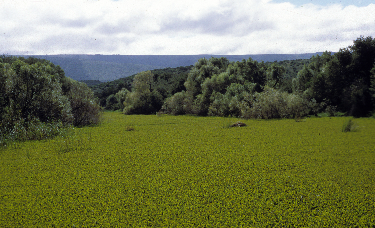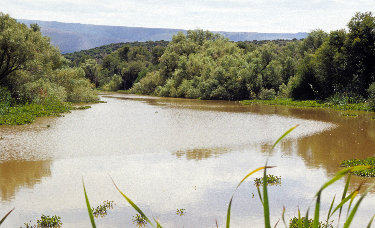Aquatic Weeds Programme
Programme Leader: Prof. Julie Coetzee
Historically, biological control efforts against aquatic macrophytes in South Africa have focused on the floating weeds, water hyacinth, Pontederia crassipes (C.Mart.) Solms (Pontederiacaeae), salvinia, Salvinia molesta D.S.Mitch. (Salviniaceae), water lettuce, Pistia stratiotes L. (Araceae), parrot’s feather, Myriophyllum aquaticum (Vell.) Verdc. (Haloragaceae), and red water fern, Azolla filiculoides Lam. (Azollaceae). Post-release evaluations over the last ten years have shown that, with the exception of water hyacinth, all of these problematic aquatic plants have been suppressed effectively using classical biological control. However, in eutrophic water bodies at high elevations that experience cold winters, an integrated approach, that includes herbicide application and augmentive biological control, is required against water hyacinth.
With numerous invasive aquatic species already established in South Africa, thriving horticultural and aquarium industries, nutrient-rich water systems, and a limited knowledge of the drivers of invasions of submerged and emergent macrophytes, South Africa is highly vulnerable to a second phase of aquatic plant problems. Experiences gained in the U.S.A. on biological control against submerged weeds, such as hydrilla, Hydrilla verticillata (L.f.) Royle (Hydrocharitaceae) and spiked/Eurasian watermilfoil, Myriophyllum spicatum L. (Haloragaceae), have provided South African researchers with the necessary foundation to initiate programmes against submerged species such as Brazilian water weed, Egeria densa Planch. (Hydrocharitaceae), while collaboration with Australian, US and European colleagues are benefitting programmes against emergent species such as Sagittaria platyphylla (Engelm.) J.G. Sm. (Alismataceae), Nymphaea mexicana Zuch. (Nymphaceae), and Iris pseudacorus L. (Iridaceae).
The main aim of the waterweeds programme is to determine pathways of new invasions, and the invasion ecology and management of emerging aquatic weeds. Competitive interactions between invasive and native species is crucial to understand, as well as modes of spread, phenology, and requirements in these invasives’ new ranges. Initiating and implementing biological control programmes on these species is the ultimate goal of the aquatic weeds programme.
Prof. Julie Coetzee is the Programme Leader and there are a range of students, in Entomology and Botany, who are doing their research on different aspects of waterweed invasion ecology in this programme.
|
|
|
New Years Dam outside Alicedale, before and after the release of the weevil Neochetina eichhorniae to control water hyacinth, Eichhornia crassipes
Key readings
Coetzee, J.A., Bownes, A. & Martin, G.D. 2011. Prospects for the biological control of submerged aquatic macrophytes. African Entomology 19(2): 469–487.
Coetzee, J.A., Hill, M.P., Byrne, M.J. and Bownes, A.B. 2011. A review of the biological control programmes on Eichhornia crassipes (C. Mart.) Solms (Pontederiacaeae), Salvinia molesta D.S. Mitch. (Salviniaceae), Pistia stratiotes L. (Araceae), Myriophyllum aquaticum (Vell.) Verdc. (Haloragaceae) and Azolla filiculoides Lam. (Azollaceae) in South Africa since 1999. African Entomology 19(2): 451–468.
Martin, G.D. & Coetzee, J.A. 2011. Fresh water aquatic plant invasion risks posed by the aquarium trade, aquarists and the internet trade in South Africa WaterSA 37: 371-380.
Coetzee, J.A. & Hill, M.P. 2012. The role of eutrophication in the biological control of water hyacinth, Eichhornia crassipes, in South Africa. BioControl 57:247–261.
Hill, M.P. & Coetzee, J.A. 2017. The biological control of aquatic weeds in South Africa: Current status and future challenges. Bothalia 47(2): 1-12.
Coetzee, J.A., Hill, M.P., Ruiz-Tellez, T., Starfinger, U. and Brunel, S. 2017. Monographs on Invasive Plants in Europe: Eichhornia crassipes (Mart.) Solms. Botany Letters 164:4, 303-326.
Coetzee, J. A., Miller, B. E., Kinsler, D., Sebola, K., & Hill, M. P. (2022). It's a numbers game: inundative biological control of water hyacinth (Pontederia crassipes), using Megamelus scutellaris (Hemiptera: Delphacidae) yields success at a high elevation, hypertrophic reservoir in South Africa. Biocontrol Science and Technology, 1-10.
Last Modified: Fri, 14 Mar 2025 09:53:25 SAST


